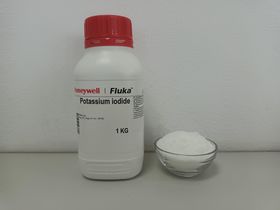Potassium iodide
 Sample of lab-grade KI
| |
| Names | |
|---|---|
| IUPAC name
Potassium iodide
| |
| Systematic IUPAC name
Potassium iodide | |
| Other names
Kali iodide
Pima Thyro-Block | |
| Properties | |
| KI | |
| Molar mass | 166.0028 g/mol |
| Appearance | White solid |
| Odor | Odorless |
| Density | 3.12 g/cm3 |
| Melting point | 681 °C (1,258 °F; 954 K) |
| Boiling point | 1,330 °C (2,430 °F; 1,600 K) |
| 128 g/100 ml (0 °C) 140 g/100 ml (20 °C) 148 g/100 ml (25 °C) 176 g/100 ml (60 °C) 206 g/100 ml (100 °C) | |
| Solubility | Slightly soluble in ammonia, diethyl ether, ethanol |
| Solubility in acetone | 1.31 g/100 ml (25 °C) |
| Solubility in ethanol | 1.88 g/100 ml (25 °C) |
| Solubility in glycerol | 40 g/100 ml |
| Solubility in methanol | 12.5 g/100 ml |
| Vapor pressure | ~0 mmHg |
| Hazards | |
| Safety data sheet | Sigma-Aldrich |
| Flash point | Non-flammable |
| Related compounds | |
| Related compounds
|
Sodium iodide |
| Except where otherwise noted, data are given for materials in their standard state (at 25 °C [77 °F], 100 kPa). | |
| Infobox references | |
Potassium iodide is the inorganic ionic compound with the chemical formula KI. It is a clear crystalline salt that serves as a convenient source of iodine.
Contents
[hide]Properties
Chemical
When treated with a strong acid such as hydrochloric acid, hydroiodic acid is formed, along with the potassium salt of the acid. A useful reagent in itself, hydroiodic acid can also be oxidized directly to elemental iodine with the addition of hydrogen peroxide. Potassium iodide, being water-soluble, is a useful source of the iodide ion in solution as well.
Potassium iodide is a very strong reducing agent. It reacts readily with any oxidizer, including oxidizing acids such as sulfuric and nitric. It may be desirable if you want to use it to reduce these acids, but undesirable if you want hydrogen iodide. To avoid unwanted redox reactions, use phosphoric acid, which is both non-volatile and exceptionally gentle to reducing agents.
Like most iodides, it will form dark brown triiodides on contact with elemental iodine.
Physical
At room temperature, potassium iodide follows the general pattern of alkali metal halides in that it appears as a colorless, odorless crystalline salt that is highly soluble in water.
Availability
Potassium iodide can be found as an iodine supplement or as an emergency medicine for radiation poisoning, which means it may be stocked by some survivalist/prepper outlets. It is easily purchased online.
In recent years, the price of potassium iodide has more than doubled. Likewise, in some EU countries, many sellers no longer sell KI to private individuals, for some reason.
Iodine tinctures are a solution of iodine with potassium iodide. Separating the latter however, is usually messy. Lugol's Iodine is a good source of potassium iodide. In USA, USP Strong Iodine Tincture contains potassium iodide, while USP Tincture of Iodine contains sodium iodide.
Preparation
Potassium iodide can easily be synthesized by the action of elemental iodine or hydroiodic acid on potassium hydroxide.
- I2 + 2 KOH + H2O → 2 KI + 2 H2O + ½ O2
- HI + KOH → KI + H2O
Projects
- Make hydroiodic acid or iodine
- Make Elephant toothpaste
Handling
Safety
Potassium iodide is a mild irritant, and due to the high mass percentage of iodine it contains, large amounts of exposure can effect the thyroid gland. It may also factor in causing birth defects.
Storage
Potassium iodide should be stored in closed containers. It will slowly give off iodine vapors, which will stain the inside of the container. Because of this, NEVER USE METAL CONTAINERS OF ANY KIND.
Disposal
Potassium iodide wastes should be diluted with water and can be poured down the drain. It's recommended to try and recycle the iodine though.
